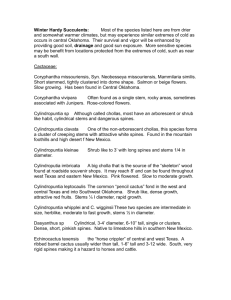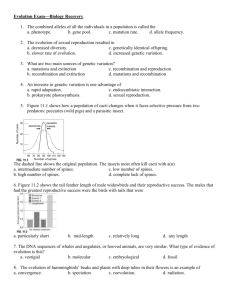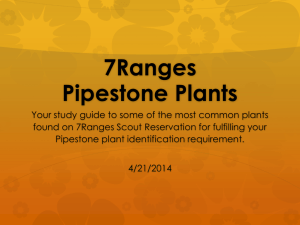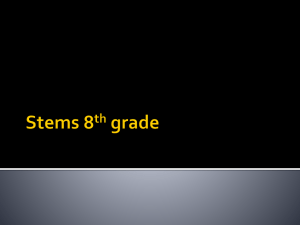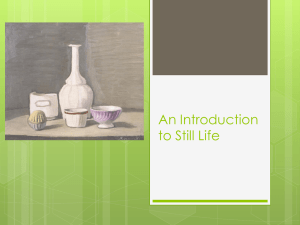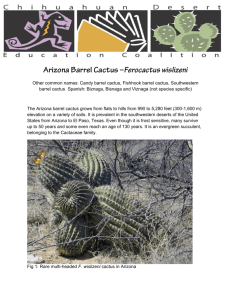Cacti of the Mojave Desert - Earth and Planetary Remote Sensing
advertisement
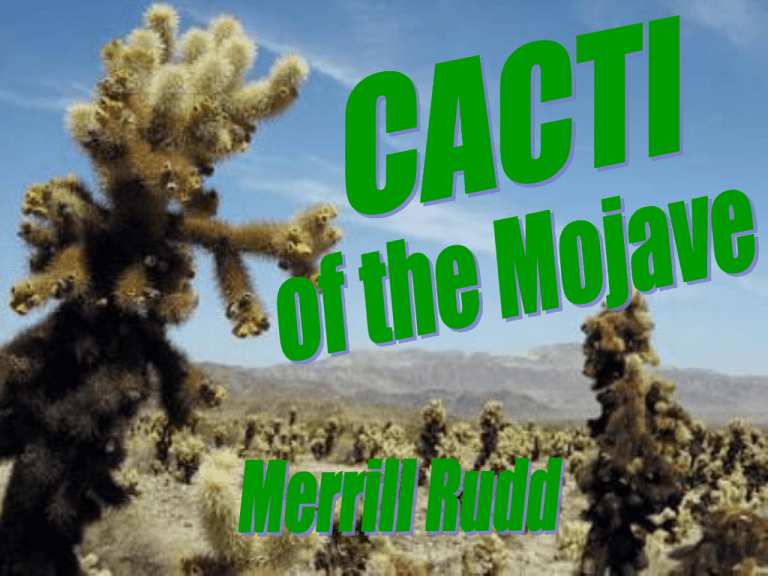
• • • • Perennial Dicotyledon- Two leaf embryo Single celled fruit Areoles- Place of all growthside branches, flowers, spines • Desert and Rainforest • Native to North America, South America, and the West Indies – Must have developed in the New World after continental drift – Warm weather and low rainfall climates – No known fossils • Crassulacean Acid Metabolism • Stomata- pores- gas and water vapor exchange – In desert- must remain closed all day to conserve water – Take in Carbon Dioxide at night • Without sunlight- can’t make sugar- make malic acid instead – Produces sugar through Calvin Cycle • Protection from animals • Water Collection- dew, downward facingdirect rainwater • Reflect light away • Grow out of areoles • Radial and central • Fully hydrated Stem- almost 100% water • Ribs and Tubercles- help stem expand and contract • Ribs- channel water to roots, shade stem • photosynthesis is inefficient cacti grow slowly • Globular shape- best for water storage- max volume, min surface area • Water converted to mucilaginous substance- not evaporated as easily (lower freezing point) • Skin- Epidermis and Hypodermis – Epidermis- covered by waxy layer, holds in water and reflects light • Fewer stomata per square area- close tighter than other plants’ stomata – Hypodermis- structural support, crystalsprotection from animals • • • • shallow, spread laterally corky layer prevents water loss Rainfall- new roots form to soak up water Drought- roots shrink- air gap, prevents water from escaping back to soil • Cylinder shaped body • 1-4 feet tall, live 20-30 years • Parallel ridges (accordian)- expand or contract with amount of water it’s holding • 3-4 inch spines • Yellow, 2 in. diameter flowers in ring around top in late spring and early summer Uses of the Barrel Cactus • Stewed by Native Americans- cabbage-like • Drank water from pulp • Used spines to make fish hooks • Flat, pad shaped, heart shaped • Green to purple color • 2 feet tall, 4 feet wide • 2-3 inch wide magenta flowers clustered at top of pads, between March and April • Grow on rocky slopes, below 6,000 feet elevation • glochids- barbed bristles organized in clusters Uses of the Beavertail Cactus • Fruit is very sweet • When pads of cactus are young, can be cooked and used as greens • About 1 foot tall • Clusters of 10 to 30 stems – Spherical to cylindrical, short stems – ribbed, with long spines • Grow on rocky slopes between elevations of 1,000 and 5,000 feet. • Cotton-like fiber grows on fruit and base of flower (yellow flower streaked with pink, blooms in late spring) – Cotton stays on cactus after fruit and flower are gone Uses of Cottontop Cactus • Panamint tribe ate the seeds of the fruit • Pulp of the stem contains watery juice • Thorns used for basket making • One stem, 2-3 inches diameter, 6-8 inches tall • Pink or magenta flowers in May and June • Sandy or rocky areas • Single stems clump together to form colonies • Found in creosote bush scrub- widely spaced shrubs on low lying expanses MORE Foxtail Cactus! • Columnar • About one foot tall • Bright pink flowers from February to Aprilclose at night and open in the morning – Grow from side of stem • Fruit is edible- about one inch long • 4-6 yellow or brown central spines (2-3 inches long) and about 10 smaller radial spines – Long and stout MORE Hedgehog Cactus • 1-500 single spherical or oblong stems grow in clusters – Stems 1 foot tall • 8-12 spines per areole – Red spines on top of stems – Areoles about a half inch apart – May be curving and flexible • Scarlet flowers- diurnal (open for 2-3 days) • Red, juicy fruit MORE Mojave Mound • • • • • Up to 3 feet tall Elliptical, oblong shape Green, brownish purple color Two or three pads jointed together Yellow flowers, two inches wide, in May and June – May become pink or orange as they age • Fruits (“tunas”) edible, covered in spines Uses of the Prickly Pear • Juice, jelly, candy, tea, and alcoholic drinks • Native Americans- used to treat burns – Used as tea to help mothers during childbirth • Mexican folk medicinetreat diabetes, ulcers, inflammation- but more clinical support • Planted on steep slopes to control erosion • • Up to 5 feet tall • Cylindrical stems, smooth, with diamond pattern One central spine per areole • 2 inches long, straight, round • Small single flower at the end of stem segment • Yellow, Orange, or Red • Grow on sandy, rocky, or gravelly soil • up to 4,000 feet elevation •Low growing and hidden in shrubs– Watch out!!! Uses for Pencil Cholla • Fruit and pad- can be eaten raw, cooked, or dried for later use • Seeds- roasted and ground up, used as thickener • Can be used to make gum – Mixed with oil to make candle • Added to plaster to make it stickier • 2-5 feet tall • Made up of short cylindrical segments • Branches densely covered by spines- about one inch long, covered by paper-like sheath • 9-20 spines per areole • Greenish-yellow flowers bloom May-June • Sandy, rocky soils • Moderate slopes • Elevation 1,000 to 5,000 feet MORE Silver Cholla • 3-4 feet tall • Cylindrical segmentseasily detached – Detached segments root and grow • Densely covered by yellowish spines • Looks soft from a distance • Cooling mechanism- protects stems from intense sunlight • Yellow-green flowers at top of stems in spring • Rocky, south facing slopes • Below elevation of 3,000 feet Uses for the Teddy Bear Cholla • Animals in the desert (such as rats) use fallen joints for protecting and camouflaging nests Works Consulted • • • • • • • • http://mojavedesert.net/plants/mojave-desert-cactus.html http://www.desertusa.com/mag98/may/stories/cactus.html http://www.blueplanetbiomes.org/barrel_cactus.htm http://earthnotes.tripod.com/cactus.htm http://www.fourdir.com/great_basin_forager_culture.htm http://calflora.net/bloomingplants/mojavemoundcactus.html http://www.drugs.com/npp/prickly-pear.html http://www.ibiblio.org/pfaf/cgi-bin/arr_html?Opuntia+ramosissima • http://www.cactusmuseum.com/survival.asp

